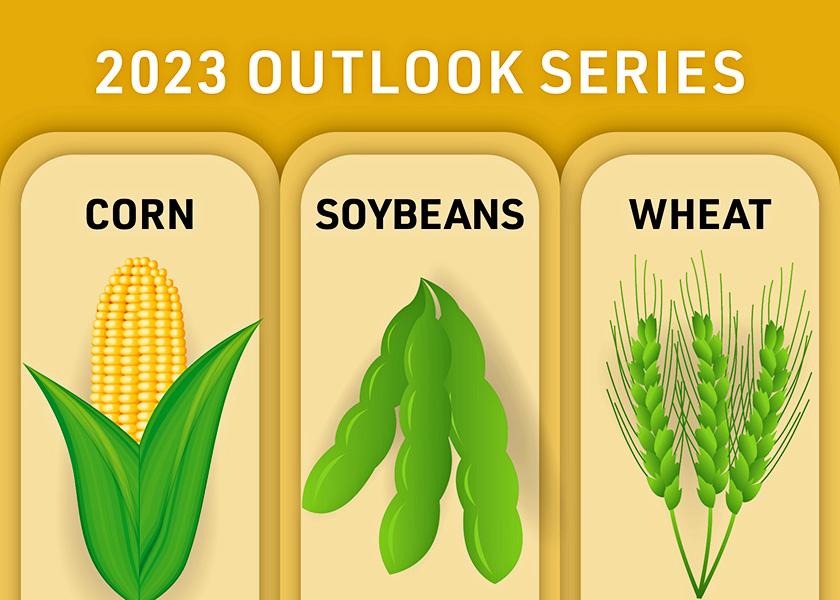Is the Low for 2023 Grains Already In? “That Depends,” Experts Say

The U.S. farm economy has farmers such as Ben Riensche of Blue Diamond Farming Company in Iowa optimistic about the future.
“I think you can say farming has a pretty good seat on the bus of inflationary times,” Riensche says. “Our output is worth more, it’s highly priced across the end-user space, our asset values are stronger, including farmland, and the machinery we have in our fleet is worth more.”
Riensche says when times are good, he searches for things that can make money while he sleeps.
“I’ve never been through an upcycle like this where I didn’t wish that I used it to get ready for that rainy day,” he says.
Strong farm income is helping him reinvest. According to USDA’s December estimate, net farm income in 2022 is forecast at $160.5 billion. If realized, it would be the highest since 1973 and more than 50% above the 20-year average – when adjusted for inflation. Net cash farm income would be the highest since USDA started keeping these inflation-adjusted numbers back in 1929.
“The last two years have seen exceptional returns to row crop producers,” says Farm Journal Economist Chip Flory. In 2022, grain prices picked up where they left off in 2021— moving higher and staying there. “As we look at the upcoming planting season of the major crops, we are looking at some of the highest profitability levels of the past two decades,” says Dan Basse, president of AgResource Company. “Farmers should lock down some of these margins and prices.”
The Kansas City fed agrees finances are strong. Loan demand is slowing, and bankers say the risk of defaults or collapse remains extremely low heading into the new year.
“When we look at the lending side, we see high levels of liquidity,” says economist Matt Roberts, formerly of Ohio State and now the senior grain and oilseed sector analyst with Terrain. “Overall, we see very low levels of stress in loan portfolios across the country.”
Ag bankers such as Alan Hoskins, president of American Farm Mortgage Company, say the stability and certainty of modern crop insurance helps to limit downside risk.
“Unless we would see commodity prices fall off the table going into 2024, it would certainly look like crop insurance is going to provide some pretty good guarantees,” Hoskins says.
New Demand Driver
The climate focus in Washington is also supporting a new demand driver for U.S. farmers — renewable diesel and sustainable aviation fuel.
“As we build out infrastructure for renewable diesel, we’ve got a 23% increase in U.S. crush rates coming over the next couple years,” Basse says. “Never before have we had 23 new crush facilities, or let’s say upgrades, occurring at the same time. So, there’s bullishness in the background here.”
Flory agrees the current surge in vegetable oil demand is something the industry hasn’t seen before.
“It's going to change the flow of soybeans and soy products around the world,” he says.
While a new demand driver has the potential to undergird grain markets in the future, it doesn’t mean there won’t be challenges ahead. After hitting near 10-year highs in soybeans corn and wheat, the question is, “What’s next for prices?”
“We really haven’t tipped over yet because we’re not sure about South American production, or next year and whether there’s a drought,” says Alan Brugler of Brugler Marketing and Management. “Prices always fall it’s just how soon.”
“It’s really tough to predict that though because of the global dynamics,” Flory adds. “On an input basis, or on a margin basis, I think maybe we’ve already seen enough of a setback that we could begin another positive move higher and a strong farm economy going forward.”
Is it possible? Yes. Will it happen? The unknowns always remain unknown.
“If the market were to see something like a global recession, or South America has big crops, or in the Black Sea, the war is over, those kinds of things would cause declines in farm income and leave us in a precarious position,” Basse explains. “Heading into 2023 we’re in a good spot. The question is, what do we want to do with the market and the opportunities ahead of us?”







